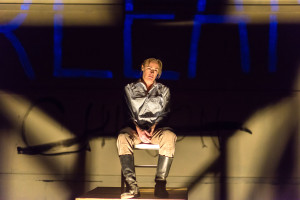Shaw’s Saint Joan Still Relevant Today

The Central Square Theatre in Cambridge Massachusetts has brought in Bedlam’s unusual production of George Bernard Shaw’s Saint Joan, written in 1923. The New York-based company, now in its second year, has specialized in performing large cast classics in meager spaces with a small number of actors, sparse scenery and minimal technical effects.
Few cuts have been made to the three-hour work written, in Shavian fashion, as a debate in which Joan has the last word. Shaw is true to the well-known tale of the medieval country girl, who by dint of religious belief, patriotism, and love of warfare, almost succeeds in driving the English out of France, is tried by the Inquisition for heresy, and burnt alive. However, his Joan is a female version of Shaw’s übermensch, a person whose superior intellect entitles him/her to lead.
Joan is played by the extraordinary Andrus Nichols, co-founder of the company. Nichols, dressed in plain contemporary clothing in lieu of armor, her hair long, contrary to the script, plays with all facets of Joan’s personality. She is warm, naïve, proud, playful, lucid, brave, as the text would have it. By turns, she elicits laughter and tears.
The twenty-three male roles – soldiers, plain folk, nobles, churchmen – are in the hands of three talented actors, Edmund Lewis, Tom O’Keefe, and actor/director Eric Tucker, the other co-founder.
Tucker’s pacing is spot on. When called for, the actors transform into other characters instantaneously and convincingly (if in an exaggeratedly vaudevillian style) by a change of accent, headgear, or glasses. Contrasting scenes, particularly Joan’s when she attempts to convince others of her rightness, as for example, when she persuades the fearful Dauphin to accept his responsibilities and become King Charles VII, are slower and minus the caricatured element.
This Saint Joan takes Brecht’s alienation effect to another level by making the public part of the show. At times, an actor sits in the audience talking to people around him. During each of the two intermissions, the set, which consists largely of platforms and three chairs, is rearranged so that audience members have to change their seats and viewing point. The entire auditorium becomes the stage.
John R. Malinowski’s simple lighting is appropriate for the directorial interpretation. The house lights remain on for much of the show. Only when Joan is on trial is the audience given a taste of theatricality. The house goes black, a halogen light shines upward revealing Joan sitting on a chair atop a table, her hands bound. Her judges, scattered throughout the theatre, exist only as tormenting voices in the dark.
Unlike many contemporary productions, which cut the epilogue because of the play’s length, much to its detriment, Bedlam’s Saint Joan retains the moving scene, which came as a surprise to the audience. The lights dimmed, giving the impression the play had ended. A long pause followed before Joan reappeared, a dream figure. In that guise, freshly canonized to her astonishment, she visits King Charles. Characters from her past return and, although seemingly glad to see her, reject her when she talks of returning to earth. Alone on stage, she sinks to her knees and, perhaps in the most moving words Shaw ever wrote, pleads: “O God that made us this beautiful earth, when will it be ready to receive Thy saints? How long, O Lord, how long?”
Underground Railway Theater at the Central Square Theater Presents Bedlam’s Saint Joan
Playwright George Bernard Shaw
Director Eric Tucker
Lighting Design John R. Malinowski
Cast
Edmund Lewis Ensemble
Tom O’Keefe Ensemble
Eric Tucker Ensemble
Andrus O’Keefe Joan
Continues until February 8, 2015